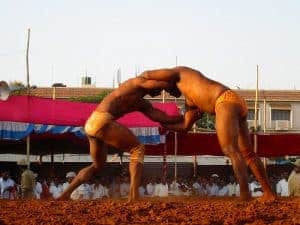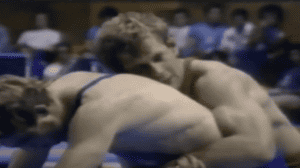When the word grappling is mentioned, most people think of a few martial arts and sports such as Brazilian Jiu-Jitsu, Sambo, Judo and Olympic Wrestling but unaware to the general public is a wide world of grappling arts.

It can be argued that grappling is the most natural method of fighting known to man, it is instinctive and within us all. That said, it is no coincidence that almost every culture and country has its own cultural wrestling and grappling fighting styles and the more you learn about these cultural wrestling styles, the more you notice that there are many common themes and techniques when it comes to grappling, the main difference is the rule sets and goal of the grappling art and wrestling styles.
Here are some of the most interesting grappling styles you’ve never heard of:
Yagli Gures – Turkish Oil Wrestling
Turkish Oil Wrestling is one of the most interesting styles of wrestling as opponents smother olive oil over their bodies and wrestle one another until one of the wrestlers wins by taking the opponent down and forcing their belly to face the sky. Matches are a maximum of 40 minutes and Yagli Gures is the Turkish national sport.
Schwingen – Swiss Belt Wrestling
Considered one of Switzerland’s national sports, Swiss wrestling is said to have originated in the 13th century although modern Schwingen was developed during the 1800’s. Wrestlers wear trousers with a special belt that they can make grips on in order to throw and takedown the opponent. The match ends when one of the wrestlers places the opponent’s shoulders to the ground. The wrestlers are allowed and encouraged to grip on the belt the entire time they are wrestling.
There are no weight classes and it is not uncommon to see very large wrestlers taking part in a Schwing festival (the name for a Schwingen tournament). The main Schwing festival in the year is called the Eidgenossische with the champion crowned as the Schwingerkonig.
Glima – Icelandic Folk Wrestling
This style of belt wrestling is one of Iceland’s national sports and was even showcased at the 1912 Olympic games. There are several styles of Glima but the most famous is the style done with a belt. Wrestlers need to hold onto each other’s belt and turn counter clockwise with the goal of the wrestler to throw, trip or takedown the opponent to the ground with a part of the body between their elbow and knees touching the ground.
Georgian Chidaoba
A form of jacket wrestling that is centuries old, Chidaoba is a very popular sport in the country of Georgia. The goal of Chidoaba is for the wrestler to successfully throw the opponent flat on the back with the shoulder blades touching. Chidaoba is so important to Georgian culture that it is even listed as an intangible cultural heritage of humanity with UNESCO.
Chidoaba is so effective that it has heavily influenced other mainstream grappling arts such as Sambo and Judo.
Lucha Canaria – Canary Island Folk Wrestling
A truly awesome style of wrestling, Lucha Canaria matches are action packed with the goal of the match being to have any part of the wrestler’s body above the knee touch the ground, in order to win a match you need to successfully takedown an opponent twice. Lucha Canaria wrestlers are allowed to grab the opponent’s shorts in order to generate leverage for throws and takedowns.
Generally competitions have a team of wrestlers vs another team of wrestlers, where they wrestle individually and once all the wrestler’s of one team have lost a match, the other team is declared the winner.
Gulesh – Azeri Traditional Wrestling
Azerbaijan’s Gulesh wrestling is so revered that it is an absolute integral part of the Azeri character, this can be seen as Azerbaijan’s national sport is Freestyle wrestling, this came from the Azeri love for Gulesh. The goal of a Gulesh wrestling match is to have the opponent’s back pinned to the ground.
It must be noted that Azerbaijan is a top rated Olympic wrestling and Judo country and the influence of Gulesh can be seen in the unorthodox grips and throws that Azeri athletes are known for.
Mongolian Bokh
Mongolian wrestling has been practiced since the times of Ghengis Khan and is an integral part of Mongolian culture. The goal of Bokh is simple, to get the opponent off their feet into the ground. It is a very technical wrestling style with over 600 total moves including 40 base techniques as well as a huge array of setups and reversals.
The largest Bokh competition is called the Nadaam Bokh Tournament and it has 1024 wrestlers wrestling for the respected title of champion. Bohk wrestlers are real athletes and well respected within Mongolian culture.
Filipino Buno and Dumog
A rather interesting grappling style, Buno and Dumog are very combat orientated with a high emphasis on taking an opponent to the ground in order to use a weapon afterwards. Filipino warrior culture is heavily based around bladed martial arts such as Kal, Escrima and Arnis and the use of grappling in order to control an opponent is very prevalent in the empty hand portion of these Filipino martial arts.
Many of the techniques are trips and takedowns into joint manipulations and chokes, it is a no nonsense grappling style but more of a secondary fighting style to the main martial arts styles of the Philippines.
Vietnamese Vat Co Truyen and Dau Vat
Vietnamese folk wrestling is a part of a larger vietnamese warrior culture, It is celebrated in festivals with Dau Vat competitions being a major attraction for spectators to watch. The goal of a match is to pin the opponent’s shoulder blades to the ground. Prior to matches, the wrestlers perform a special dance as ritual.
Ssireum – Korean Belt Wrestling
A highly popular sport in Korea and one of Korea’s national sports, Ssireum is a style of belt wrestling that is highly technical and extremely fast. Ssireum matches are won when a wrestler forces the opponent to touch the ground with any part of the body that is from the knee and above. Ssireum is televised nationally and is a very important part of Korean culture, in fact so important that Ssireum is listed as an intangible cultural heritage at UNESCO. Former Pride fighter Choi-Hong Man was a former Ssireum wrestling champion.
Senegalese Wrestling – Njom, Laamb
An absolutely action packed wrestling style, Senegalese wrestling is the national sport of Senegal. Senegalese wrestling is very technical and allows for strikes which makes it a very competent combat style as well.
The goal is to get the opponent to the ground so their back, back ofthe head adn bittocks touch the floor or in some cases when a wrestler has 2 hands and 2 knees touching the ground. Senegalse wrestlers are like rock stars in Senegal, achieving true fame and fortune.
Senegalese wrestler Oumar Kane is a successful MMA star who has used Senegalese wrestling techniques to dominate his opponents in the MMA cage.
Indian Kushti and Pehlwani Wrestling
One of the oldest types of folk style wrestling is Kushti (which is also known as Pelwani). It is the parent to many international grappling styles and world grappling styles, especially in the Indian sub continent and neighbouring countries.
Kushti is practiced in a mud pit which is made out of mud, clay mixed with oil and ground turmeric, it is a very physical and technical type of wrestling that is practiced all throughout India.
The goal of a Kushti match is to pin the opponents hips and shoulders simultaneously on the floor. In certain matches, submissions are allowed.
Shuai Jiao – China’s Wrestling Art
Originally made for the battlefield hundreds of years ago, Shuai Jiao has developed into several different styles, all with different rules and techniques. Shuai Jiao matches are incredibly technical and fast with the main goal to takedown the opponent. There are styles of Shuai Jiao that allow submissions, joint locks and even strikes as well. Shuai Jiao is the grappling component of modern Sanda which has seen success in Modern MMA through the domination of the Sanda practitioner Zabit Magomedshariov over opponents in the UFC.
In Conclusion
Every country and culture has some sort of grappling and wrestling art within, it is part of who we are as humans and there is no doubt that many of the cultural styles of the globe have influenced modern grappling styles of the world and perhaps will re-enter modern MMA combat as a force to reckon with once again.




